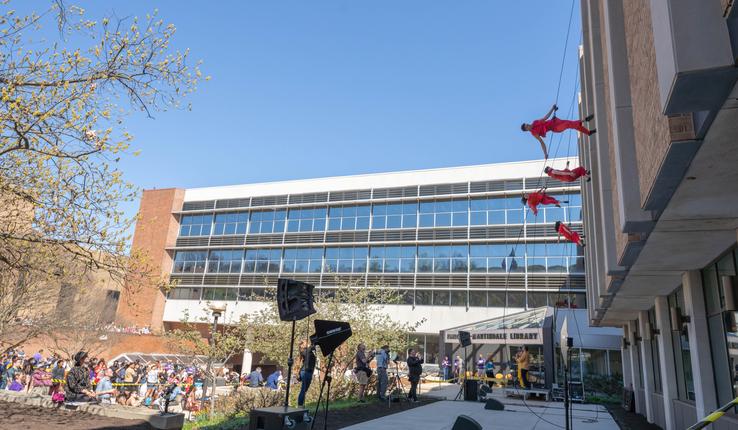Provost Nathan Urban, in his welcome, acknowledged that institutions are grappling with, and trying to predict, the use of generative AI within and beyond higher education. But because its application is relatively new, he said, he sees an opportunity for a university—potentially Lehigh—to become known as a place with expertise in this area.
“What would ‘doing this well’ look like?” Urban asked, inviting feedback. “What would it mean to be the university that is identified as doing the best job adapting to, incorporating, integrating, leading in the area of the application of generative AI to teaching, to research, to operations?” He said that “doing it well” would also mean “doing it ethically,” taking into consideration the nature of bias.
Urban gave four premises: that generative AI tools will improve, that the tools will increase in their usage to the point that they will be nearly ubiquitous in certain domains, that the tools and technologies will set a new baseline for competence, and that they will be problematic in possibly introducing bias into the work that is generated.
“What should we do about this?” he asked. “What steps should we take? I would argue that the steps that we should take include widespread dissemination of information about these tools, widespread training of students, faculty, staff in the effective and ethical use of these tools.”
Urban said that he doesn’t believe that the Lehigh community can ignore generative AI or pretend that it won’t impact students in their lives. Therefore, he said, “I think we need to recognize and actively engage as a campus, especially with our students, in the ways in which these tools will shape the future.”
A discussion on “The Implications of Generative AI for Teaching and Learning at Lehigh” featured the following panelists: Elizabeth Young Miller, social sciences librarian; Greg Skutches, director of writing across the curriculum; Suzanne Edwards, associate professor in the English Department; and Larry Snyder, the Harvey E. Wagner Endowed Chair Professor and Director, Institute for Data, Intelligent Systems, and Computation (I-DISC).
Presented with a scenario in which a student asks about using ChatGPT, Miller suggested that a student might use the AI chatbot to perhaps brainstorm terms or keywords to kickstart research, then explore the library’s resources on one’s own. She and the other panelists cautioned that the technology is limited and that information provided is unsourced and uncited.
“I actually feted some difficult research questions back in December,” Miller said, “and it didn't give me the responses that I wanted. So it's drawing from primarily free resources, it's not up to date, and it can be missing really important voices.”
Other presentations over the two-day symposium included: “Bringing the complexities of virus structure to life through 3D modeling,” by Larry Tartaglia, CITL faculty fellow; “Conversing with AI to Get Good Answers: How to Ask Good Questions,” by Jeremy Littau, associate professor of journalism and communication; “Using PhotoVoice to Teach Ecological Systems Theory in the Social Sciences, by Russell McIntire, associate professor in the Department of Community and Population Health, and Katie Bucher, Community College of Philadelphia; “Individual In-Person Assessments in Lieu of a Final Exam” by Stephanie Prevost, visiting professor of law; “Data visualization in education—Processing complex and large number data sets,” by Zilong Pan, CITL Faculty Fellow (Teaching, Learning, and Technology); and “Teaching with Art and Material Culture: Engaging Students in Multidisciplinary Learning,” by Stacie Brennan, curator of education, Lehigh University Art Galleries (LUAG), and Elise Schaffer, coordinator of museum experience and access, LUAG.
Students also showcased their posters on the issue of generative AI.






